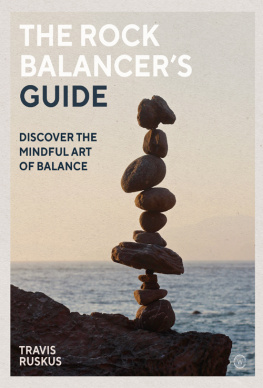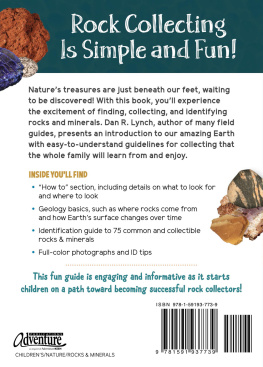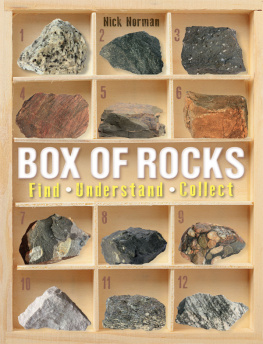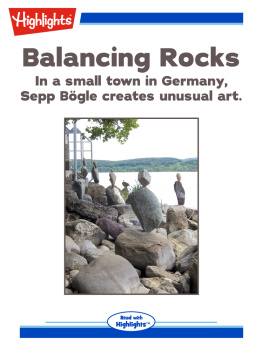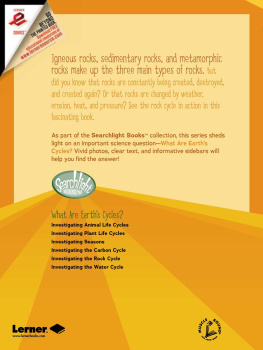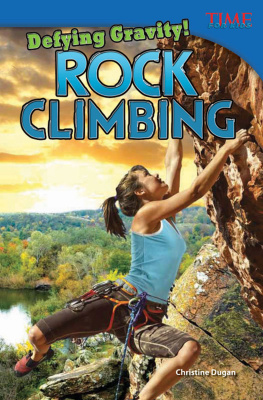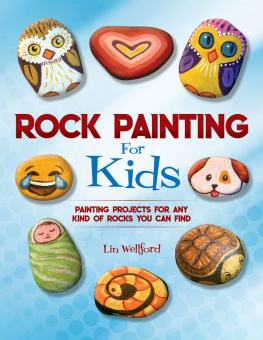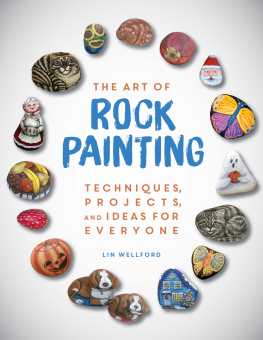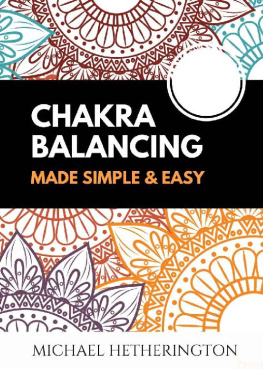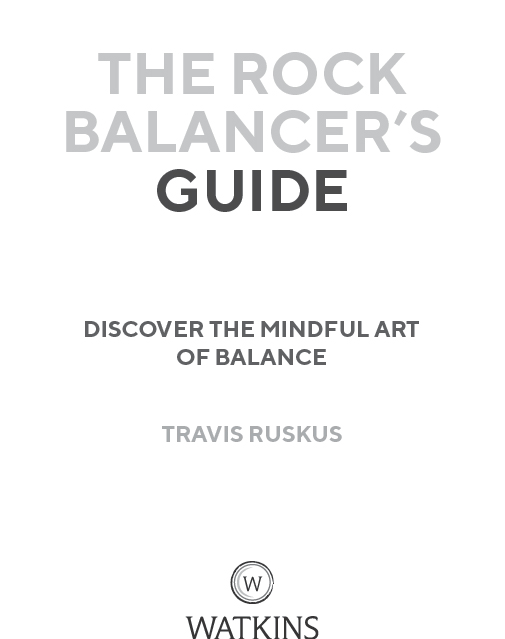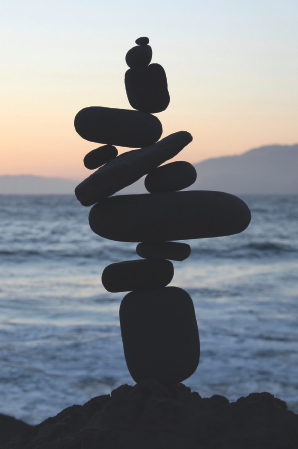THE ROCK
BALANCERS
GUIDE
This book is dedicated to those in pursuit of enlightenment.
CONTENTS
INTRODUCTION
WELCOME
My name is Travis Ruskus and I am a rock-balance artist currently based in San Francisco, California. Much like yours, my journey has been long and complex. I have experienced great moments of victory and humbling defeats. One of the lowest times in my life led me to discover the art of rock balancing and for that I am incredibly grateful.
Rock balancing is an art form in which stones are balanced naturally on top of each other to create beautiful formations, without the aid of any artificial props, adhesives or supports. It is also a metaphor for life and the circle of creation of beginnings and endings. As with any new skill, the deeper you go, the more you will discover. My intention with this book is to give you the technical knowledge that will allow you to balance rocks, along with the wisdom that goes with this practice.
The art of rock balancing has been around for thousands of years, and this guide is part of a reawakening of a lost ancient wisdom. Through rock balancing, I will teach you how to make and then let go of your creations, freeing yourself into the next moment. As you will discover, if you can learn how to let go of your balances, it will be easier to let go of other things in life.
Start at the bottom and slowly build with each breath you take.
WISDOM OF THE STONES
Rock balancing requires patience and focus, which makes it a powerful form of mindfulness and moving meditation. It cannot be rushed; it invites us to connect with the present moment. After all, everything that ever happened in the history of time has led us to this moment. This moment will happen only once. Rock balancing reminds us to use this moment wisely.
Like other mindfulness practices, rock balancing is linked to the power of the breath. If I could teach you one thing in this entire book, its to remember to breathe: to focus calmly and mindfully on the air entering and leaving your body (see Find Your Breath, pages ). We experience a state of physical and mental clarity whenever we stop and simply breathe for a few moments. This quality of being is a state of mindfulness, reached by quietening the loud voices of the ego in order to listen to the true voice of your soul.
The power of the breath will take your rock balances to the next level, and help you find clarity in each moment including this one.
ONE ROCK AT A TIME
Starting with the breath, the chapters in this book share the seven keystones of rock balancing:
1. BREATHE: In the first chapter, we experience how the breath connects us with the energy of each moment. By the end of this book, you will be well on the way to discovering your true power, one breath at a time.
2. OPPORTUNITY: As new doors open, we discover in this chapter how a mindful practice of rock balancing can help us to face our fears and overcome them to unlock our potential.
3. BELIEVE: In my experience of teaching others how to balance rocks, 95 percent of people say I cant before they even pick up a rock and try. This chapter looks at how the art of rock balancing can be a tool for creating belief and confidence.
4. BALANCE: Balance is a state of mind, as well as a physical condition. A balanced rock creates a balanced mind. In , we find out more about the ways in which rock balancing encourages equilibrium and focus.
5. LIMITS: This chapter reveals how learning to rock balance teaches us to reconsider the limits we set ourselves and exceed our own expectations, setting us on the path toward realizing the infinite potential within ourselves.
6. RELEASE: In the circle of life, everything that is created will eventually be destroyed. Letting go is one of the hardest things to do, but we must learn to do it. There is no other choice. This chapter is about the importance of release.
7. EVOLVE: I believe rock balancing can help change the way we see the world. Through its principles, we can discover how to evolve into our true selves and follow our dreams.
The seven keystones of rock balancing are designed to shift your perspective on what is possible within yourself. No one else can do this but you. These principles will give you all the tools you need to succeed at this art form, as well experience its wider impact on your life. You might get your first rock to balance and then go mad sharing this gift with others (like I did). Or perhaps just one sentence in this book will connect with you at exactly the right moment and help you unlock a problem or come up with a new idea. Where you go from there will be entirely up to you
AN ANCIENT ART
Wherever rock balancing takes you, you might be interested to know that this ancient art has been around in one form or another for thousands of years. Since prehistory, people all over the globe have set stones upright and piled up rocks in cairns for a wide range of purposes, from marking routes, burial monuments and buried items, to highlighting astronomical events, to providing shelter for hunters, herders and livestock. Around the world today, rock structures continue to be used as markers of different kinds.
NORTH AMERICA: For some 12,000 years indigenous trail guides have used rock balancing on their bu?alo hunts, while indigenous peoples of the Arctic used stone structures known as inukshuk as navigational aids. Today, the Canadian government frequently uses rock balances as nautical channel markers, and inukshuk are still created as art forms and landmarks.
SOUTH AMERICA: Cairns have been used to mark trails since pre-Columbian times throughout what is now Latin America. They also had a spiritual use: in the Andes mountains, for example, cairns were built as shrines to the Incan earth goddess Pachamama.
EUROPE: Europe is known for its surviving prehistoric stone structures, from dolmens to standing stones to burial cairns, which were raised from the Neolithic era. Stonehenge, for example, is known for its iconic trilithons, formed of two massive stone uprights with a third block placed as a lintel across the top. As elsewhere in the world, cairns have been used in Europe through history in different ways as landmarks. For example, between Iceland and mainland Europe lie the Faroe Islands, where clifftop cairns warned navigators of the dangerous offshore rocks that were often concealed by fog.
AFRICA: The stone structures of Africa range from simple shelters to protect against the sun to Egypts magnificent pyramids and burial mounds that conceal incredible treasures. Viewed from afar, these stone edifices have an imposing presence. As we get closer, we become aware that each pyramid has been made from rocks balanced on top of each other. The Great Pyramid of Giza, for example, has a mass of 6.5 million tons and is built out of 2.3 million stones weighing nearly 3 tons each. Now that is one powerful rock balance.
ASIA: In South Korea, rock balances are common on mountain hiking trails. They are also found next to Buddhist temples, where the tradition is to add another rock on top of the existing balance to generate good luck. This ancient custom is in honor of San-shin, the Mountain Spirit. In Nepal and other places influenced by Tibetan Buddhism, it is common to see mani stones carved with mantras or symbols piled up in cairns by the roadside.
Next page
